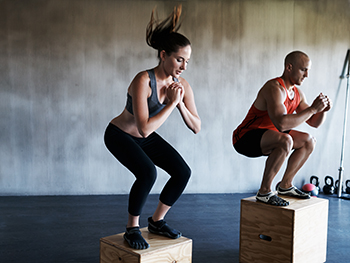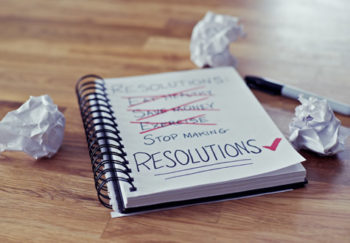
With the new year here, many of us will be flocking to the gym or queuing up exercise videos to get a jump on our resolutions. And with our new workout routines may come muscle soreness. But how sore is too sore and indicates something else? I met up with David Hryvniak, MD, to find out.
What Causes Muscle Soreness?
Mild soreness after a workout is generally not a bad thing. It’s just a sign that the muscle has been taxed. The stress on the muscle causes microscopic breakdown of muscle fibers, which in turn causes discomfort. The muscle breakdown serves a purpose: when those fibers rebuild, the muscle is stronger.
Some types of exercise cause more soreness than others. For example, “eccentric” activity (when the force is put on the muscle as it lengthens, such as when running downhill or lowering the weight in a hamstring curl) causes more soreness, because it puts more strain on the muscle.
DOMS
Have you ever been sorer the second or third day after a workout than you were the first day after? This is called delayed onset muscle soreness, or DOMS. The soreness is delayed because it takes a while for some metabolic & physiological processes (the results of those microscopic muscle tears) to manifest as muscle pain.
- DOMS pain is at its worst 48-72 hours after a hard workout.
- There isn’t much you can do to treat DOMS. It should improve on its own after about 72 hours.
- The best way to prevent DOMS is to be sure you’re building up your activity gradually.
Massage and foam rolling may help with DOMS. “I generally tell people foam rolling ‘hurts so good.’ It’s painful, but it gets those waste products like lactic acid moving and out of your muscles and soft tissue,” Hryvniak says. Just be sure not to roll directly over bones or joints if you try foam rolling. Stick to soft tissue like your glutes, hamstrings, and calves.
Is It Rhabdomyolysis? When to Contact a Doctor for Muscle Soreness
If you haven’t urinated in a long time or have dark colored urine, or if the soreness just isn’t improving after 48-72 hours, it’s a good idea to seek medical attention. These can be symptoms of rhabdomyolysis or “rhabdo.”
Muscle tissue releases an enzyme called creatine kinase (CK) when it breaks down. That’s normal, and a certain amount of CK in your system is fine. But a high amount of it can cause rhabdo, which affects the kidneys and can even cause kidney failure.
Unlike DOMS, rhabdomyolysis is a serious condition that requires medical attention. It usually happens when someone jumps right into heavy activity without building up to it.
If you’re starting a new workout routine and doing it gradually, the risk of rhabdomyolysis is extremely low. It typically only occurs after extreme exercise, but some other things can increase your chances of it:
- Being dehydrated
- Exercising while you’re on medications like ibuprofen or Aleve
- Exercising in the heat
Hryvniak says the best way to know if you might have rhabdo is to look at your urine quality. “In someone with rhabdomyolysis, the urine is tea colored. Some of that is the breakdown materials (CK) and some of it is dehydration. In someone with rhabdo, the muscle soreness will seem way out of proportion to the level of effort and won’t seem to be improving.”
Rhabdo is a dangerous condition, so if you suspect you have it, you’ll want to see a physician or visit the emergency room that day for evaluation.
You’ll also want to see a doctor if pain is keeping you from getting back to the same activities once your soreness has gone away. That may indicate an injury.
Exercising When You’re Already Sore
According to Hryvniak, whether or not you should work out when you’re sore just depends on how sore you are. “My rule is that working out with a little bit of stiffness or soreness is okay. If it’s a 1, 2 or 3 out of 10, that’s okay. If it’s getting above that, or the pain is getting worse during activity, or if you’re limping or changing your gait, back off the intensity of the workout.”
Dealing with an injury?
The UVA Runner’s Clinic is the only clinic in the area with a program specifically for runners. The physicians are all experienced runners and board certified sports medicine physicians. They treat all physically active people with a special focus on the endurance athlete.
Make an appointment with the UVA Runner’s Clinic by calling 434.243.5600.
How to Avoid Soreness
Hryvniak says the jury is still out when it comes to scientifically proven ways to prevent muscle soreness. He advises the following:
- Warm up prior to intense activity.
- Stretch well before and after your workout.
- Keep moving! Gentle walking and stretching after a workout will help keep those waste products from settling into your muscles and help prevent DOMS.
- Be gradual! If you slowly increase the load on your muscles, soreness will be less of an issue.
Avoiding Soreness: Advice for Starting a New Workout Routine
Most of Hryvniak’s patients end up in his office because of doing too much too soon. Maybe they’re increasing their running distance, adding in hills too quickly or jumping into a workout they’re not ready for. He sees things like stress fractures, Achilles tendinitis, runner’s knee, plantar fasciitis and hamstring injuries.
The risk of soreness shouldn’t deter people from beginning a workout program. Hyrvniak encourages an active lifestyle. “All the research backs up the benefits of activity. Whether it be running, walking, playing pickup basketball or golfing. All of those activities are going to be good for your cardiac health, your joint health and your overall health. But I also encourage people to be slow with their progress and increase gradually. Don’t make sudden changes to the surfaces you train on, the volume or intensity of your workouts, or even to your workout equipment. It’s sudden transitions like those that tend to cause injuries.”


Thanks
Foam roll to get rid of lactic acid?😂